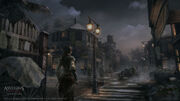New Orleans is a city located in southeastern Louisiana, a critical trade route that linked the Mississippi River and the Gulf of Mexico. Founded in 1718, it immediately became an important economical, political and cultural center for trade and commerce.
History
In 1765, French rule over New Orleans ended and the city was officially handed over to the Spanish. During this time, the French governor of New Orleans, Jean-Jacques Blaise d'Abbadie, made a deal with the Templar Rafael Joaquín de Ferrer to remain as governor, provided he oversaw the hand-over of the colony to the Templars. However, he was assassinated inside his mansion by the Assassin Aveline de Grandpré following a meeting with de Ferrer.[1]
The Templar Order used the colony's transfer to gain access to the highest levels of government and extend their operations.[2] After setting up a covert slave trafficking operation, the Templars worked with French and Spanish officials in diverting slaves and vagrants from New Orleans to a work camp in Mexico, to excavate First Civilization ruins in search of an artifact known as the Prophecy Disk.[1]
The following year, the Spanish governor Antonio de Ulloa arrived in the city, but brought with him a small force of soldiers and did not raise the Spanish flag over the city. Two years later, he applied rigid trade laws and restrictions within the New Orleans to better serve the Templar Order and allowed their plot to transport slaves and workers to go ahead. In response, French Creoles rebelled against his regime, forcing de Ulloa to take shelter in La Balize outside of the city.

Rebels resisting de Ulloa's regime
During this time, the Mentor of the Assassins, Agaté, ordered Aveline to assassinate de Ulloa. Doing as she was assigned, Aveline drew the governor out of La Balize and ambushed his carriage. However, after learning of the plans to divert slaves and vagrants south to Mexico, she decided to spare his life in return for a lens used to decode Templar documents, a map leading to the work camp in Mexico and de Ulloa's promise to go into exile.[1]
On 1 November 1768, under the approval of the French King, the Spanish commissioned de Ulloa's replacement, General Alejandro O'Reilly to suppress the rebellion and punish those responsible. To prevent any further violence, the French Creole leader urged citizens to avoid military confrontation and accept Spanish authority.[2]
In 1776, Aveline attended a soirée on the outskirts of New Orleans, in order to locate a Templar named Vázquez, as she believed he was the "Company Man", the head Templar in Louisiana. Aveline charmed Vázquez and lured him to quiet corner before assassinating him, but he revealed in his final words that he was not the Company Man and that it was actually a woman, but died before he could reveal her name.[1]
Whilst away in New York, Aveline learned that the true identity of the Company Man was her own stepmother, Madeleine de L'Isle. She returned to New Orleans and confronted her stepmother, who admitted that she had manipulated Aveline's life to groom her for induction into the Templar Order, as she believed they shared a common goal.[1]
Aveline agreed and traveled to Saint Louis Cathedral, where she was inducted into the Templar Order by Madeleine, after having faced off against her Mentor Agaté. However, her induction was merely a ruse to eradicate the Templars from within, and Aveline eliminated all of the Templars present, before confronting Madeleine. She attempted to persuade Aveline that her work was for the benefit of humanity, but Aveline refused to serve Madeleine and assassinated her.[1]
In 1801, Spanish rule ended and the city was handed back to the French. However, French rule ended two years later when Napoleon Bonaparte sold the colony to the United States, a transaction directed by the United States President, Thomas Jefferson.[1]
Layout
New Orleans had a number of characteristic, scenic elements. As a prominent center for trade and commerce, the city was also a culturally diverse environment and full of life. Dotted with trees and lush gardens, the city's buildings were often constructed with angled roofs and decorative features such as balconies and gazebos. Marketplaces and courtyards were a common sight in New Orleans, and its streets were openly spaced with little traffic moving through them. A multifarious society, the general populace of New Orleans was varied, with a range of different people inhabiting the city.
Founded as a French city, the colonists of New Orleans were usually of French origin and wore similar styles of clothing, often a mix between the wealthy and the poor. However, with a wide slave society, servants in New Orleans were a common sight, often dressed in civilized clothing similar to that of the colonists. Notable landmarks in New Orleans included Saint Louis Cathedral, the Place d'Armes, Saint Peter's Cemetery, Congo Square, Madame John's Legacy, the Governor's mansion, the de Grandpré mansion and the de Grandpré warehouse and Assassin headquarters.[1]
Trade
Being an integral link in the transport of goods, the de Grandpré business thrived in New Orleans. Headed by Philippe Olivier de Grandpré, the company shifted hands to that of his accountant Gérald Blanc on Philippe's death, though it was secretly ran by that of his daughter Aveline.
Aveline could then purchase and sell goods and ships, with New Orleans itself desiring tobacco, pitch, fabric, ice and providing cotton, sugar and molasses.
Gallery
References
| ||||||||||||||||||||||||||||||||||




